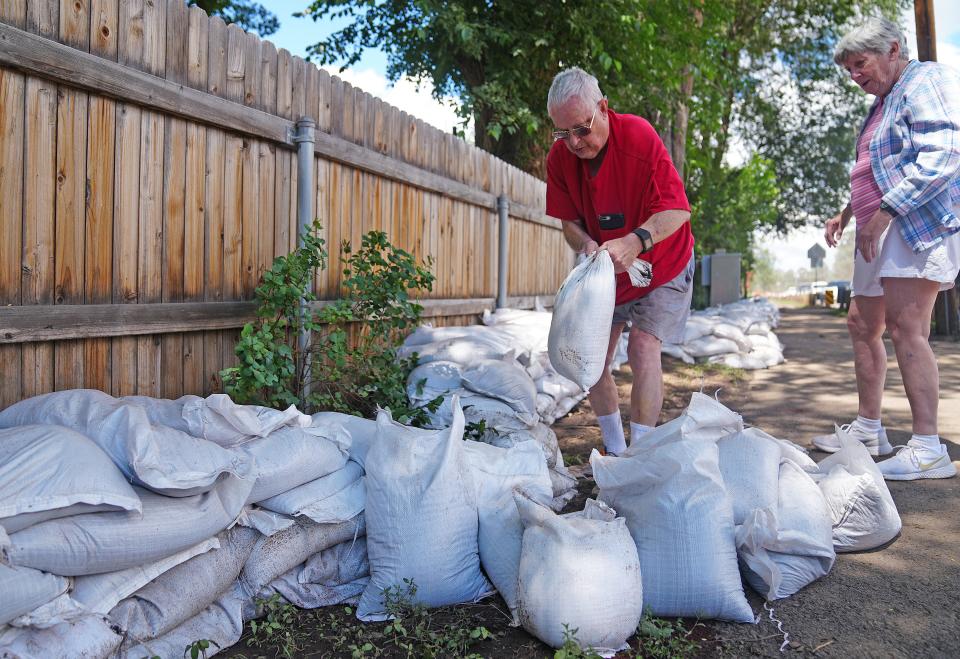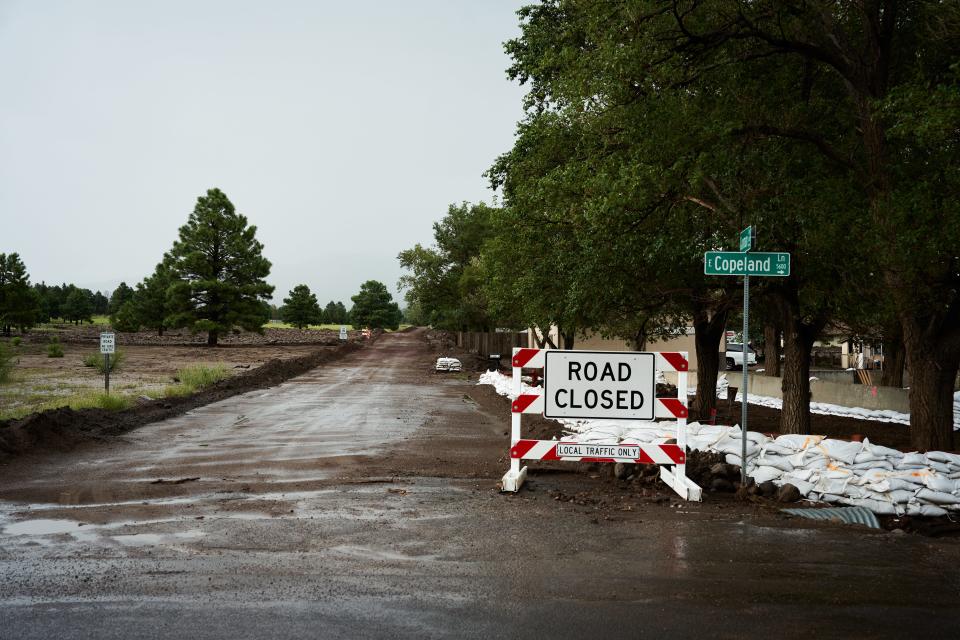How to prepare your family and home for wildfires and floods in Arizona
While in Arizona, wildfire and monsoon seasons have officially ended this year, it is never too early to prepare for natural disasters.
When people are evacuated during a wildfire, some don’t know it could be the last time they'll walk out the door of their home. This was the case for Cindy Kenniger, who had to evacuate during the Tinder Fire north of Payson, which burned 16,309 acres in 2018, and returned to a home reduced to ashes.
"It's just so much to lose," Cindy Kenniger told The Republic at the time. She said it took time for her to understand what she and her husband lost.
In July, Maryjane García-Stanley found her mom Suzette García trapped under the kitchen wall and the stove that was once part of what used to be her trailer home in south Scottsdale. García's was one of several homes that had been blown away by a strong monsoon storm that swept across the Valley.
García had severe injuries to her back and underwent back surgery. She was expected to walk again after her treatment. She told The Arizona Republic, at the time, she planned on staying with her daughter until she found a new place since she lost her home to the storm.
State officials have said Arizona no longer has a wildfire season, emphasizing that drought conditions have put some areas at risk of catching fire throughout the year. And while monsoon season is short, some residents have been left without a home following heavy storms.
According to the National Flood Insurance Program, just 1 inch of water can cause $25,000 worth of damage to a home.
The costs associated with a wildfire are difficult to calculate since they can be long-term. However, a 2021 study by the Northern Arizona University’s Ecological Restoration Institute that surveyed residents who live in areas affected by the 2010 Schultz Fire and post-fire flooding revealed that 22.5% of them didn’t file an insurance claim and have paid on average about $12,000 out of pocket in the last decade.
About 10.5% of the surveyed residents said they were still working on repairs from the damages caused by fires or floods.
After disasters hit, residents may not know who to reach out to for help, especially for longer-term recovery, or where to file a complaint if they feel their insurance isn't covering what they should.

To answer some of these questions, The Arizona Republic sought answers from state and federal agencies. To best prepare, officials recommend having insurance to protect properties and recover from the disaster. But knowing the limits of insurance policies, how adjustors operate post-disasters and understanding the credibility of an insurer is even more important.
Consult an insurance agent for the right policy
To make sure insurance can indeed help someone get back on their feet after a natural disaster, people should consult with an insurance agent or with the company about what policy is best for them, according to James McGuffin, assistant director at the Automobile Theft Authority & Public Information Division in the Arizona Department of Insurance and Financial Institutions.
“Many times, when you have a disaster happen to you and then you go in and you try to figure out how to recover from that, you find out that your insurance was not adequate and that you didn't have things in order,” McGuffin said. “So the most important thing a homeowner can do is to visit with their agent before the disaster strikes and determine what they have to cover.”
With an agent, McGuffin said people can go over how much their home is worth and discuss if they have valuables inside or if they need coverage for other structures in their properties, such as barns.
He recommended that people make a documented inventory of valuable items so that in cases of loss or damage, they can show it to the insurance company.
Understand the insurance process and your policy
When a disaster does hit, insurance companies have adjusters who are sent out to assess the value of what was lost.
“You're going to have lost probably personal property that you can't replace. No amount of money can replace like photographs or heirlooms or things like that, personal things. … What you want your insurance to do is to get you back to as close to normal as possible,” McGuffin said.
If someone’s home wasn’t destroyed, but requires repairs, keeping records of those repairs is advisable as some people may get reimbursements, depending on the policy. Policies can also cover the contents of someone’s house.
When people are displaced from their homes, some policies may even cover alternate living expenses for some time depending on the insurance coverage, said McGuffin.
Wildfire guide: Your Arizona wildfire questions answered, including how to be prepared
McGuffin said people should understand that if the full cost of their losses exceeds the policy limit, some losses won't be covered by insurance companies, even if there is a way to prove that value. To avoid that, McGuffin emphasized the importance of meeting with an agent and ensuring adequate insurance.
Research to find the right insurance policy
Many companies offer homeowners insurance in Arizona so costs can vary, McGuffin said. He said people should do research and check if complaints about companies have been made.
“When you're shopping insurance, it's more than just about money, the cost of the premium. It's about the company and their ability to pay claims and their history of being fair and honest with consumers,” McGuffin said.
People who feel that their insurance isn’t complying with their policy or lack communication about a claim can file a complaint to the Arizona Department of Insurance and Financial Institutions.
The department will intervene if they find a discrepancy between what the company did and what the policy says they will do, McGuffin said.
Flood insurance: a policy all its own
Losses due to wildfires are often covered by homeowner’s insurance. However, for other natural disasters such as earthquakes or flooding, separate insurance policies may be necessary.
In Arizona, monsoon season brings heavy rain that can lead to flooding, especially in areas where wildfires have left the ground burned, without vegetation and unable to absorb water. McGuffin said people who live in an area where a wildfire happened should consider buying flood insurance depending on where their home is located.
The Federal Emergency Management Agency has the National Flood Insurance Program, which was established to help communities before, during and after a flooding disaster. The program’s website has a tool to find flood insurance providers in each state, including Arizona.
It usually takes 30 days for a flood insurance policy to go into effect, according to NFIP’s website. There are some exceptions for this waiting period, such as when a property is impacted by flooding on burned federal land. In this case, the policy has to be purchased within 60 days of containment of the wildfire.
Some of the suggestions the NFIP has on their website to prepare before a flood include learning about a home’s flood risk. People can look up their addresses in the Flood Map Service Center to learn if their area is prone to flooding.

People who live in high-risk flood areas and hold a NFIP policy may receive up to $30,000 to help cover costs to have their home comply with their local floodplain management ordinance and regulations. More information on this additional coverage can be found here: https://www.fema.gov/floodplain-management/financial-help/increased-cost-compliance.
Saving copies of important documents and storing the original ones in a watertight safety deposit box, as well as an inventory is advised before a flood.
To minimize flood losses, FEMA encourages people to elevate and anchor utilities like appliances, waterproof any basements, clear debris from gutters and move furniture to a safe place. People can also buy items to prevent flood damage such as sandbags or water pumps.
When flooding is predicted, NFIP policyholders are eligible for up to $1,000 to buy supplies to avoid floods such as sandbags. The NFIP policy term is of one year and people remain covered for 30 days after the expiration.
“When a flood is imminent or occurring, your first priority should be the physical safety of you, your loved ones, and your pets,” the NFIP website states.
Policies from the NFIP don’t cover damage from mold, which is why the program suggests policyholders begin cleanup and documentation as soon as possible after a flood. However, if an official banned entrance to the area or floodwaters are still around the home or in the area, mold damage may be covered.
Those who are thinking of rebuilding after a flood should discuss with a contractor the options for elevating and strengthening the home for possible future floods, according to the NFIP.
The NFIP website has more information on buying a policy, renewing a policy, documents needed for flood insurance claims and other resources to assist people before, during and after flooding.
While resources are available to help people that aren’t related to insurance, McGuffin said having insurance can help a lot for long-term recoveries as sometimes the help organizations can provide are short-term.
“I think that's kind of the overarching theme here," McGuffin said, "that people who have disasters happen to them and they have good insurance, they're able to have some resiliency, they're able to recover quicker because they get the payoff and they can start rebuilding or moving on with their life in a different place”
“But people who don't have insurance or adequate insurance find themselves, you know, not being able to rebuild or not being able to recover financially. So it's kind of a long-winded thing there.”
Reach breaking news reporter Angela Cordoba Perez at Angela.CordobaPerez@Gannett.com or on Twitter @AngelaCordobaP.
Support local journalism. Subscribe to azcentral.com today.
This article originally appeared on Arizona Republic: How to prepare for wildfires and floods in Arizona: Insurance is key

